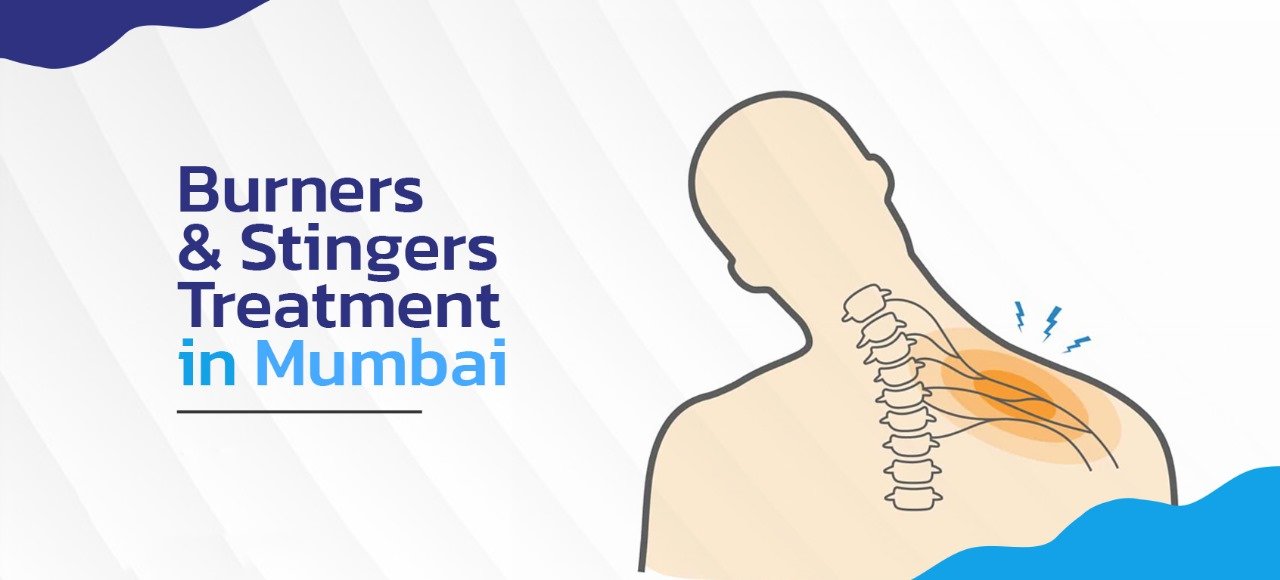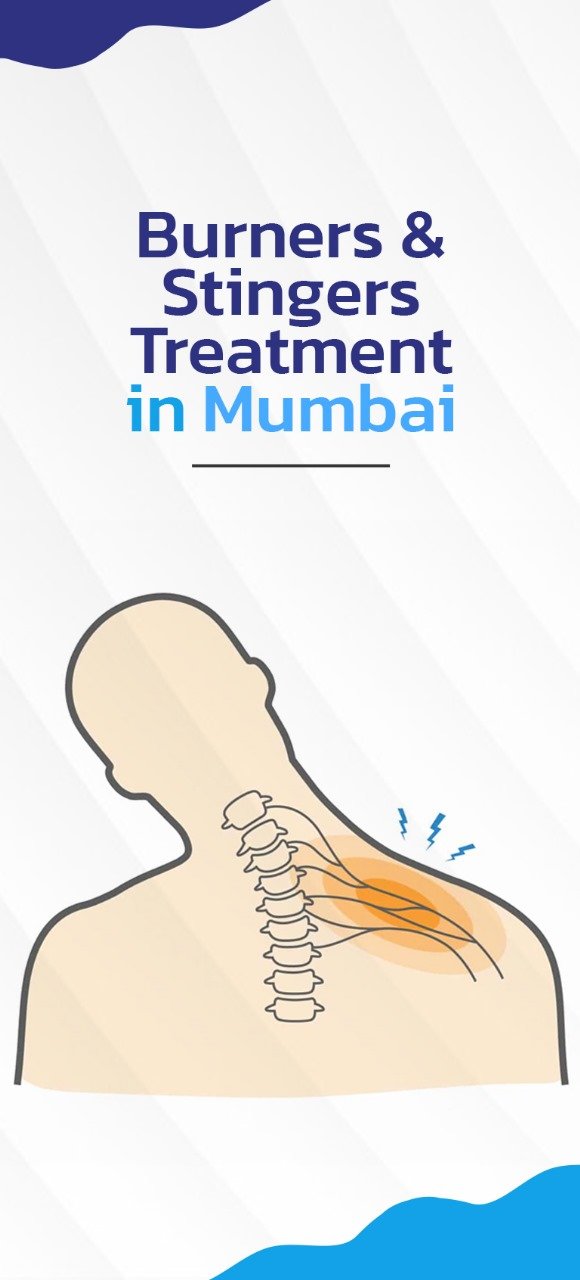

Specialized Burners and Stingers Treatment in Mumbai: Ensuring Effective Recovery
For those in Mumbai grappling with burners and stingers from sports, prompt and specialized burners and stingers treatment in Mumbai is crucial. Seeking care from experienced professionals ensures effective recovery, addressing pain and weakness. Stay active with confidence by prioritizing personalized treatment plans tailored to your sports-related nerve injuries.

Looking for burners and stingers treatment in Mumbai? Consult Dr. Priyank Patel,
If you are in search of specialized care for burners and stingers treatment in Mumbai, look no further than consulting Dr. Priyank M. Patel, one of the best doctors for burners and stingers in Mumbai. With expertise in both surgical and non-surgical management of spine-related disorders, Dr. Patel stands out for his sub-specialty in spine tumors. His credentials include being one of the youngest independent surgical consultants empaneled in a leading tertiary hospital in Mumbai, with extensive international training in advanced spinal procedures. Dr. Patel’s approach emphasizes conservative methods whenever possible, promoting an active lifestyle with corrective exercise and strength conditioning, and advocating surgery only when necessary.
Beyond his role as a surgeon, Dr. Patel is actively involved in The Spine Foundation, contributing to the development of new surgeons and undertaking philanthropic initiatives like establishing rural spine care centers across India. With a future vision to create a National Spine Tumor Foundation, Dr. Priyank Patel is dedicated to advancing spine care, particularly in the realm of spine tumors, making him one of the top burners and stingers specialists in Mumbai. If you’re seeking comprehensive and expert care for burners and stingers, Dr. Priyank Patel is a trusted professional and burners and stingers surgeon in Mumbai.
What are burners and stingers?
Burners and stingers refer to neurological injuries, also known as brachial plexus injuries, commonly associated with trauma to the neck or shoulder region. These injuries often occur in contact sports or accidents involving sudden movements of the neck or shoulder. The brachial plexus, a network of nerves controlling the muscles of the shoulder, arm, and hand, can be compressed, stretched, or impacted, leading to distinct symptoms.
Classifications of Stingers and Burners
Classifications of stingers and burners are typically based on the severity and duration of the symptoms, providing a framework for understanding and managing these nerve injuries.
Grade I: Mild Stingers or Burners
- Characteristics: Temporary symptoms lasting only a few seconds to minutes.
- Symptoms: mild burning or tingling sensations with no significant weakness.
- Recovery typically resolves spontaneously without major intervention.
Grade II: Moderate Stingers or Burners
- Characteristics: Symptoms lasting longer than a few minutes but less than a week.
- Symptoms: increased intensity of burning or stinging, with possible temporary weakness.
- Recovery: This often requires rest and may involve physical therapy for faster resolution.
Grade III: Severe Stingers or Burners
- Characteristics: Prolonged symptoms lasting more than a week.
- Symptoms: intense pain, prolonged weakness, and potential loss of motor function.
- Recovery: Medical intervention may be necessary, including more extended rest and rehabilitation.
Recurrent Stingers or Burners
- Characteristics: Multiple episodes over time, indicating underlying issues.
- Causes: chronic conditions or anatomical factors contributing to recurrent nerve compression.
- Management: comprehensive evaluation to address root causes, often involving specialized care and long-term preventive measures.
Understanding the classifications helps healthcare professionals tailor treatment plans, ensuring appropriate care for individuals experiencing stingers and burners based on the severity and nature of their symptoms. For those in Mumbai seeking burners and stingers treatment, specialized care is available through experienced burners and stingers specialists in Mumbai who can provide comprehensive evaluation and personalized management.
Causes of Burners and Stingers
The causes of burners and stingers, also known as brachial plexus injuries, are typically associated with trauma or compression to the nerves in the neck and shoulder region. These injuries commonly occur in contact sports or as a result of accidents involving sudden and forceful movements. The brachial plexus, a network of nerves responsible for controlling the muscles of the shoulder, arm, and hand, can be affected by various factors, leading to the characteristic symptoms of burners and stingers.
Direct Impact or Trauma
- Sudden blows to the head, neck, or shoulder region during contact sports like football, rugby, or wrestling.
- Motor vehicle accidents result in forceful neck movements.
Neck hyperextension or hyperflexion
Overstretching or rapid movement of the neck beyond its normal range is commonly seen in sports-related activities.
Shoulder separation or compression
Trauma causing separation of the shoulder joint or compression of the brachial plexus during falls or collisions.
Nerve compression or stretching
Prolonged pressure on the nerves due to poor posture, repetitive motions, or occupational activities.
Anatomical Factors
Individual variations in the anatomy of the brachial plexus may contribute to increased susceptibility.
Understanding the diverse causes of burners and stingers is crucial for athletes, healthcare professionals, and individuals engaged in physical activities. Recognizing these risk factors can aid in implementing preventive measures and promoting safer practices to reduce the incidence of these nerve injuries. For those in Mumbai seeking expert care, finding the best doctor for burners and stingers in Mumbai or a skilled burners and stingers surgeon in Mumbai is essential for a comprehensive and effective treatment approach.

Symptoms of burners and stingers
The symptoms of burners and stingers, also known as brachial plexus injuries, manifest as a result of trauma or compression to the nerves in the neck and shoulder region. These symptoms are often acute and transient, typically occurring on one side of the body, and can vary in intensity. Common manifestations include-
- Burning or stinging pain: A sudden, sharp, and intense burning or stinging sensation typically radiates from the neck down to the arm on one side.
- Numbness and Tingling: Temporary loss of sensation or tingling in the affected arm, often described as “pins and needles.”
- Weakness: A temporary loss of strength or weakness in the muscles of the affected arm makes it challenging to perform normal activities.
- Electric shock sensation: Some individuals may experience an electric shock-like feeling during the injury, indicative of nerve involvement.
- Limited Range of Motion: Difficulty moving the neck or shoulder, often due to pain and muscle involvement.
- Symptoms Duration: Symptoms are usually short-lived, lasting from a few seconds to minutes, but in more severe cases, they may persist for a longer duration.
It’s important to note that the severity and duration of symptoms can vary from person to person. While these symptoms often resolve spontaneously, seeking medical attention, especially if symptoms persist or recur, is crucial for proper diagnosis and management. If you’re in Mumbai, finding the right healthcare professional, such as a Burners and Stingers doctor in Mumbai, is essential. They can provide a comprehensive evaluation and guide individuals towards the best treatment for burns and stingers in Mumbai based on the specific nature of their symptoms.
Diagnosing Burners and Stingers
Diagnosing burners and stingers, also known as brachial plexus injuries, involves a comprehensive evaluation by healthcare professionals. The process typically includes-
- Medical History: Gathering information about the individual’s medical history, including any previous injuries or conditions that may contribute to the symptoms.
- Physical Examination: A thorough physical examination focusing on the neck, shoulder, and arm to assess range of motion, strength, and sensory function. This helps identify signs of nerve involvement.
- Neurological Examination: Assessing the function of the brachial plexus and associated nerves through neurological tests, such as checking reflexes and evaluating sensory responses,.
- Imaging Studies: In some cases, imaging studies like X-rays, magnetic resonance imaging (MRI), or computed tomography (CT) scans may be conducted to visualize the structures of the neck and shoulder and rule out other potential causes of symptoms.
- Electromyography (EMG) and Nerve Conduction Studies: These tests measure the electrical activity of muscles and the speed of nerve signals, helping to pinpoint the location and severity of nerve damage.
- Clinical Assessment: Evaluating the nature and duration of symptoms, considering factors such as the mechanism of injury, to determine the appropriate classification of the burners and stingers.
- Specialized Consultation: Seeking consultation with specialists, such as neurologists or orthopedic surgeons, for a more in-depth evaluation and to develop a tailored treatment plan.
An accurate diagnosis is crucial to determining the severity of the injury and guiding appropriate management. For individuals experiencing burners and stingers in Mumbai, consulting with healthcare professionals, including specialists if necessary, ensures a comprehensive and personalized approach to diagnosis and subsequent treatment. It’s also essential to consider factors such as burners and stingers treatment in Mumbai and inquire about burners and stingers surgery costs in Mumbai when exploring treatment options, ensuring a well-informed decision-making process.
Preventing Stingers and Burners
Preventing stingers and burners, also known as brachial plexus injuries, involves a combination of awareness, proper technique, and conditioning to minimize the risk of these nerve injuries, particularly in sports and physical activities. Consider the following preventive measures:
- Proper Technique: Athletes and individuals engaging in physical activities should be trained in and consistently practice proper techniques to reduce the risk of excessive neck or shoulder movements that could lead to nerve compression.
- Strength and Conditioning: Strengthening the muscles around the neck, shoulders, and upper back through targeted exercises can provide added support and stability, reducing the vulnerability of the brachial plexus to trauma.
- Warm-Up Exercises: Adequate warm-up routines before engaging in sports or intense physical activities help prepare the muscles and joints, promoting flexibility and reducing the likelihood of sudden, forceful movements causing injury.
- Protective Equipment: Athletes in contact sports should use appropriate protective gear, such as helmets and shoulder pads, to minimize the impact on the neck and shoulders during collisions or falls.
- Education and Awareness: Coaches, trainers, and athletes should be educated about the signs, symptoms, and risk factors associated with stingers and burners. Heightened awareness enables prompt action and reduces the likelihood of exacerbating injuries.
- Avoiding Overuse: Individuals engaged in repetitive activities, especially those involving overhead motions, should incorporate rest periods and avoid overuse, helping prevent cumulative stress on the brachial plexus.
- Regular Check-ups: Athletes and active individuals should undergo regular check-ups with healthcare professionals to monitor their overall musculoskeletal health and address any concerns or vulnerabilities promptly.
- Adherence to medical advice: Individuals who have previously experienced burners or stingers should adhere to medical advice and rehabilitation plans. Completing prescribed exercises and following guidelines reduces the risk of recurrent injuries.
- Rule Compliance in Sports: Adhering to the rules and regulations of sports and activities helps maintain a safe playing environment, minimizing the risk of collisions or tackles that could lead to brachial plexus injuries.
- Comprehensive Training Programs: Coaches and trainers should implement comprehensive training programs that include not only skill development but also injury prevention strategies, fostering a culture of safety in sports and physical activities.
By integrating these preventive measures into training routines and promoting awareness, individuals can significantly reduce the risk of experiencing stingers and burners, ensuring a safer and more sustainable engagement in sports and physical pursuits. For those in Mumbai, consulting with burners and stingers specialists in Mumbai and considering burners and stingers treatment in Mumbai adds an extra layer of proactive care and specialized guidance.
Burners and stingers treatment options
The treatment options for burners and stingers, also known as brachial plexus injuries, vary depending on the severity of the injury. Here are some common treatment approaches.
- Rest and Conservative Management: Mild cases often resolve with rest, avoiding activities that exacerbate symptoms. Applying ice, using anti-inflammatory medications, and gentle stretching may help alleviate pain and reduce inflammation.
- Physical Therapy: A structured physical therapy program is crucial for recovery. Therapists focus on strengthening and flexibility exercises, improving posture, and enhancing overall shoulder function. This aids in restoring range of motion and reducing the risk of recurrence.
- Medication: Non-prescription or prescription medications, such as nonsteroidal anti-inflammatory drugs (NSAIDs) or muscle relaxants, may be recommended to manage pain and reduce inflammation during the recovery period.
- Bracing and Support: Supportive braces or slings may be used to immobilize and protect the affected arm, reducing stress on the injured brachial plexus and promoting healing.
- Activity Modification: Adjusting activities and avoiding movements that strain the neck or shoulders are crucial during recovery. This helps prevent further irritation to the brachial plexus and supports the healing process.
- Steroid Injections: In some cases, corticosteroid injections may be administered to reduce inflammation and alleviate pain. This is often considered for individuals with persistent or severe symptoms.
- Surgical Intervention: Surgical treatment is reserved for more severe cases, especially those involving structural abnormalities, nerve compression, or significant damage. Surgery aims to decompress the nerves, repair damaged structures, or reconstruct the brachial plexus.
- Rehabilitation and Gradual Return to Activity: Once symptoms improve, a gradual return to activity is advised under the guidance of healthcare professionals. Rehabilitation continues to ensure optimal strength, flexibility, and function.
- Patient Education: Educating individuals about their condition, proper self-care, and preventive measures is integral. This includes guidance on posture, exercise techniques, and recognizing early signs of recurrence.
- Specialized Consultation: Seeking consultation with healthcare professionals, including specialists in brachial plexus injuries, ensures a tailored and comprehensive treatment plan. This is particularly important for complex cases or situations where symptoms persist.
- Follow-up Care: Regular follow-up appointments with healthcare providers monitor progress and allow for adjustments to the treatment plan as needed. This ongoing care helps address any lingering issues and ensures a well-supported recovery.
For those in Mumbai seeking specialized care, consulting with the best doctor for burners and stingers in Mumbai ensures access to expertise and region-specific treatment options.
Burners and stingers Recovery Time
The recovery time for burners and stingers, also known as brachial plexus injuries, varies widely based on the severity of the injury and the chosen treatment approach. Here’s a general overview-
- Mild Cases: Individuals with mild cases of burners and stingers may experience a relatively rapid recovery. Symptoms can resolve within a few days to a few weeks with rest, conservative management, and supportive measures.
- Moderate Cases: Moderate cases, where symptoms are more persistent, may require a more extended recovery period. With a comprehensive rehabilitation program, including physical therapy and activity modification, recovery can take several weeks to a few months.
- Severe Cases: Severe cases, especially those requiring surgical intervention, may have a more prolonged recovery time. The post-surgery rehabilitation process is often gradual, spanning several months. Achieving optimal function may continue for a year or more.
- Individual Factors: Individual factors, such as overall health, adherence to treatment plans, and the presence of any underlying medical conditions, can influence recovery time. Additionally, the effectiveness of rehabilitation exercises and the body’s response to treatment play crucial roles.
- Return to Activity: The timing for a safe return to sports or other physical activities varies. It depends on the individual’s progress, the specific demands of their activities, and clearance from healthcare professionals. Returning too soon can increase the risk of recurrence or complications.
- Follow-up and monitoring: Regular follow-up appointments with healthcare providers are essential during the recovery phase. These appointments allow for monitoring progress, adjusting treatment plans as needed, and addressing any lingering issues or concerns.
- Preventive Measures: Engaging in preventive measures, such as continued strength and flexibility exercises, proper technique, and activity modification, can contribute to the long-term well-being of individuals who have experienced burners and stingers.
It’s crucial to note that each person’s recovery journey is unique, and timelines can vary. A healthcare professional, often in collaboration with physical therapists and specialists, will guide individuals through the recovery process. The goal is not only to alleviate symptoms but also to promote optimal function and reduce the risk of recurrence. Individuals in Mumbai can benefit from seeking specialized care, including consulting with a Burners and Stingers surgeon in Mumbai, to ensure a comprehensive and region-specific approach to recovery.
Advantages of Burners and Stingers Treatment in Mumbai
Discover the advantages of burners and stingers treatment in Mumbai, where advanced technology, infrastructure, top-tier doctors, and easily available medical resources ensure comprehensive and effective care.
Advanced Technology
Mumbai boasts cutting-edge medical technology, facilitating precise diagnostics and treatment planning for Cauda Equina Syndrome (CES). State-of-the-art equipment allows for accurate imaging studies, ensuring a thorough understanding of the condition and enabling targeted interventions.
Advanced Infrastructure
The healthcare infrastructure in Mumbai is characterized by modern hospitals and specialized clinics. These facilities provide a conducive environment for comprehensive treatment, offering a range of medical services and amenities to enhance patient care and comfort.
Top Experienced Doctors
Mumbai attracts top-tier medical professionals and specialists. Experienced doctors, particularly those specializing in orthopedics and neurology, bring a wealth of knowledge and expertise to the field of burner and stinger treatment. Their skills contribute significantly to accurate diagnosis and effective intervention.
Easily Available Medical Resources
Mumbai’s healthcare ecosystem ensures easy access to a wide array of medical resources. Whether it’s specialized equipment, pharmaceuticals, or rehabilitation services, the city’s healthcare network is well-equipped to provide timely and comprehensive resources for the treatment of burners and stingers.
In conclusion, Mumbai emerges as the premier destination for Burners and Stingers treatment. Capitalizing on advanced technology, experienced specialists, and a robust healthcare infrastructure, the city offers access to the best doctors and surgeons for burners and stingers. With readily available medical resources, including cost-effective options, Mumbai ensures a comprehensive approach to care. Whether seeking specialized treatment or managing surgery costs, individuals can confidently navigate their recovery journey in Mumbai’s esteemed healthcare system. If you are looking for Burners and Stingers treatment in Mumbai, consult with experienced Burners and Stingers specialists in Mumbai. The best doctor for burns and stingers in Mumbai can provide personalized care. If surgery is necessary, consider the expertise of a skilled Burners and Stingers surgeon in Mumbai. Enquire about the Burners and Stingers surgery cost in Mumbai and explore options for the best treatment for Burners and Stingers in Mumbai.
Frequently Asked Questions
Burners and stingers refer to injuries commonly associated with contact sports, especially those involving physical collisions or impacts. These injuries typically involve the nerves in the neck and shoulder regions.
A burner, also known as a “nerve burner” or “stinger,” is a transient injury that affects the nerves in the neck and shoulder. It usually occurs when the head is forced to one side, stretching the nerves and causing a sudden burning or stinging sensation that may radiate down the arm.
Burners and stingers are often caused by a sudden impact, collision, or forceful tackle that results in the head being forced to one side. This can stretch or compress the nerves in the neck and shoulder, leading to the characteristic symptoms.
Symptoms include a burning or stinging sensation that radiates from the neck down the arm on one side. Temporary weakness or numbness may also be experienced. Symptoms typically resolve within a short period of time, but recurring episodes can occur.
While burners and stingers are usually temporary and resolve on their own, repeated occurrences can lead to more serious issues. It’s essential to seek medical attention to rule out more severe injuries and to develop a plan for prevention and management.
Diagnosis involves a thorough medical examination, including a detailed history of the injury and its symptoms. Imaging tests like X-rays or MRIs may be ordered to rule out other potential causes of symptoms.
Initial treatment involves rest, ice, and anti-inflammatory medications to reduce pain and swelling. Physical therapy may be recommended to improve strength and flexibility, and a gradual return to activity is typically advised.
While complete prevention is challenging, athletes can take steps to reduce the risk of burners and stingers, such as proper conditioning, strengthening exercises, and using proper technique during sports activities. Protective equipment may also play a role in injury prevention.
It’s crucial to consult with a healthcare professional if symptoms persist, worsen, or if there is a recurrence of burners and stingers. Additionally, immediate medical attention is necessary if there are signs of more severe injuries or neurological issues.
In most cases, athletes can return to sports after a period of rest and rehabilitation. However, it’s essential to follow the guidance of medical professionals and ensure that there are no underlying issues that could pose a risk of further injury.

